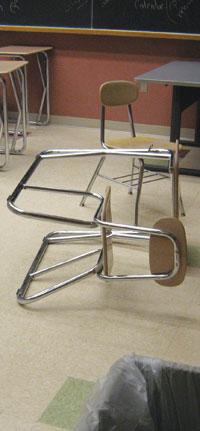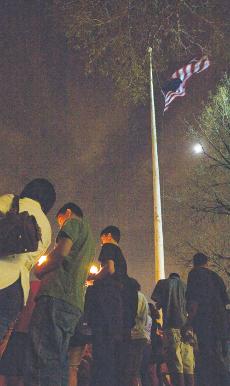Class Dismissed?

Photo by Conor Napier
February 12, 2007
Though last semester’s fervor over course cancellation remains a hot topic of debate here on our UMass campus, the most visible face of this discussion has shifted somewhat over the course of the passing months. Last season’s grumbling students have been largely replaced by organized groups of faculty, both tenured and adjunct, as the most vocal opponents to the administration’s application of their policy for canceling low enrolled courses. These faculty members are protesting not only the effect that this policy has on their own schedules, including last-minute changes in the courses they teach or even complete dismissal from teaching duties all together, but also the effect which they feel this policy inevitably has on the students and on the university’s reputation as a whole.
Currently, undergraduate courses that have fewer than 12 registered students, and graduate courses that have fewer than eight students, are in violation of the minimum required enrollment numbers to keep a course open. The stricter enforcement of this policy resulted in 91 courses being canceled last semester, a dramatic increase from spring 06’s total of 59. The final data for this years course cancellation figures are not yet available.
The disapproval of the policy’s application has motivated several faculty groups in a number of colleges to take independent action to express their opposition and to encourage a reexamination of how the policy is being administered. The Graduate Student Assembly has issued a statement of concern over how the policy is affecting their college and invites the provost as well as all seven university deans (their own college currently operating without an acting dean) to discuss the policy and its application.
Teachers from the Lecturer’s Committee of the Faculty Staff Union have organized a petition which they plan to present to the provost once they have collected over 2,000 signatures. This petitioning action was coupled with a tabling event which took place at the start of the semester. Not only does their tabling and petition efforts help raise awareness on the issue, but it also helps demonstrate the widespread support for their initiatives which they can then use in their case which will eventually be brought to the provost as well as their respective deans.
The CPCS Curriculum Council have been exploring the possibility of having their courses re-categorized from their current status as “lectures” to “seminars,” which not only would allow their course minimums to drop from 12 to eight, but also would more accurately reflect the nature of the format in which their courses are taught. CPCS’s courses utilize both in-class and non-classroom modes of learning, and many faculty feel that the categorization of their classes as “lectures” should appropriately be reconsidered.
Though this policy has been in place since 2002, it wasn’t until fall 05 that the administration first began to take a serious look at how it had been enforcing this policy. Their conclusion was that it had been enforced only loosely.
In response to this lax application of policy, and motivated by mounting budget concerns, the administration acted in what it felt was the proper response – enforce the existing policy and eliminate courses which are not seen as needed, as is evident by its low enrollment status. If enough students aren’t signing up for a course to meet its minimum requirement, this logic goes, then this is a sign that there is not enough interest in that course to justify the university budgeting a teacher to teacher it.
“The whole purpose is we want to teach courses that are needed,” said Peter Langer, the Associate Provost who works on the oversight of the policy. “If a full time faculty member doesn’t have a full load and were paying that full time faculty member their salary, it is both responsible and appropriate to ask that person to move to teach a course that’s needed.”
Not so, says many of the faculty members who are most directly effected from this current application of the policy. When a course that is canceled is being taught by a tenured full-time faculty member, they often need to pick up additional courses in order to meet the full course load, allowing them their tenured status. What this means is that when one of their course are dropped, they then must pick up another course that is being taught by other part-time adjunct faculty and are subsequently forced to quickly put together a lesson plan from the remains which the now defunct adjunct faculty member left behind.
The consequences of this policy are compounded when consider not only the university’s heavy reliance on adjunct faculty, but also since this last-minute, bump-and-switch routine occurs just a single week before classes start. This highlights an inherent problem with the current policy – how does the administration accurately gauge whether or not a class will be under enrolled until the final day that students are able to actually enroll for a course?
They can’t, says Professor of Philosophy Gary Zabel, who is helping to lead the petition drive of the Faculty Staff Union’s Lecturers Committee. “Its not just a matter of saying you need 12 students to have a course run,” Zabel said. “They’re requiring that the 12 students be enrolled more than a week before the beginning of the term.”
Many students postpone registration right up until classes start, often in an attempt to straighten out their schedules due to a number of reasons, not the least of which is these very course cancellations. “Canceling classes before add/drop makes a mockery of the idea of add/drop,” said Cuff Ferguson, the Chair of CPCS’s Curriculum Council.
But at the same time, the administrations feels that they need to use some intelligent discretion when making a decision to cancel a course or not. Expecting that every under enrolled course could possibly be filled by the start of the semester does not mean that it probably will. The department chair of these under enrolled sections are then expected to show strong compelling justification for keeping an under enrolled course open or else the course will be dropped. Ultimately, it is up to the discretion of the dean of each college to make a decision on whether or not a course is canceled. Courses that are necessary for incoming freshmen or are depended upon by graduating seniors for completion of their degrees, as well as courses that have historically shown that they are capable of meeting the minimum requirement of students by the start of the semester, are generally seen as meeting the provisions set by the administration to remains available.
But simply deciding whether a class meets the technical requirements of being necessary or whether it is exorbitant enough to spare is not always so simple. Smaller programs such as CPCS and the Graduate Program already struggle with limited resources for students. A long-term solution to this problem would likely not conclude that even more resources should be cut due to simple budget tightening. The administration’s current application of the course cancellation policy seems to be asking these programs to accomplish the impossible – “Increase the students numbers and we’ll give you more resources. But you need the resources to attract the students,” said Ferguson in explaining this conundrum.
Ultimately, a simple solution to the matter does not seem easily at hand. While it is clear that the university’s administration does need to look for ways of closing the budget gap and that under enrolled courses are an area that warrant considerable evaluation, it is not clear that the current administering of the policy is the most effective way of going about it, both for faculty, students, or the administration.





























































